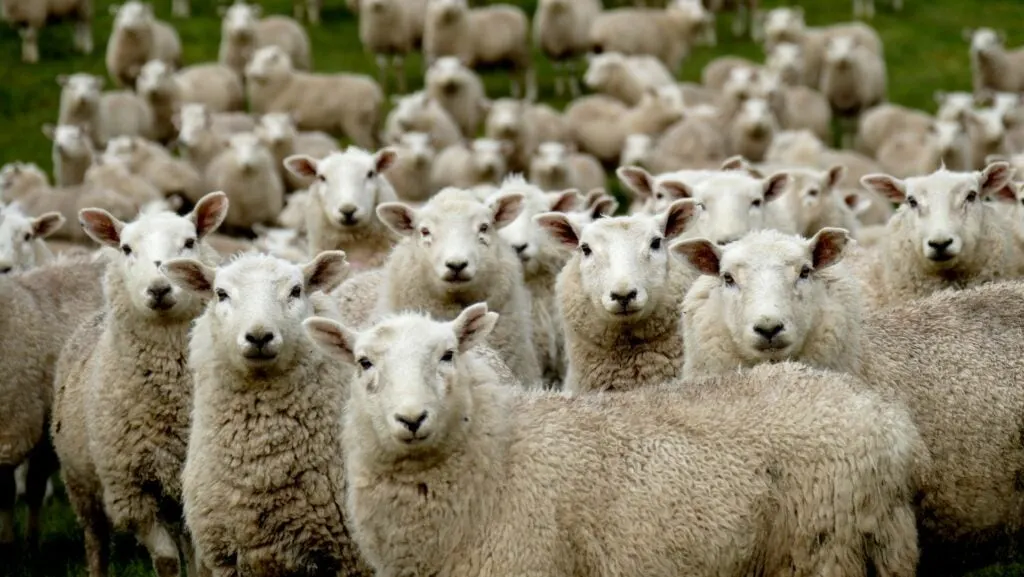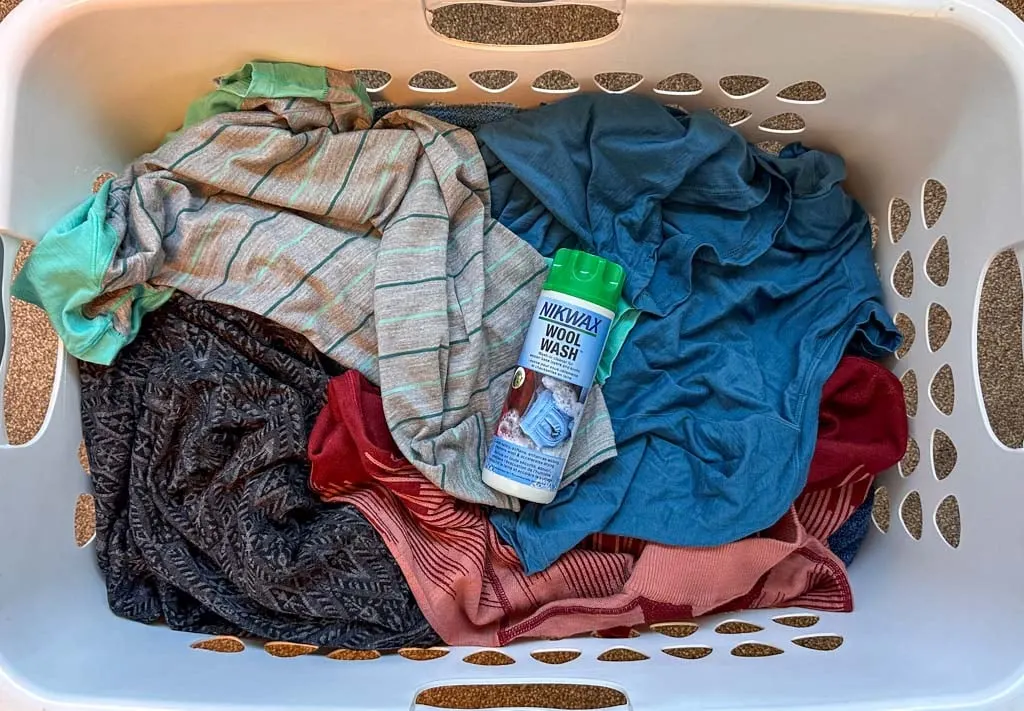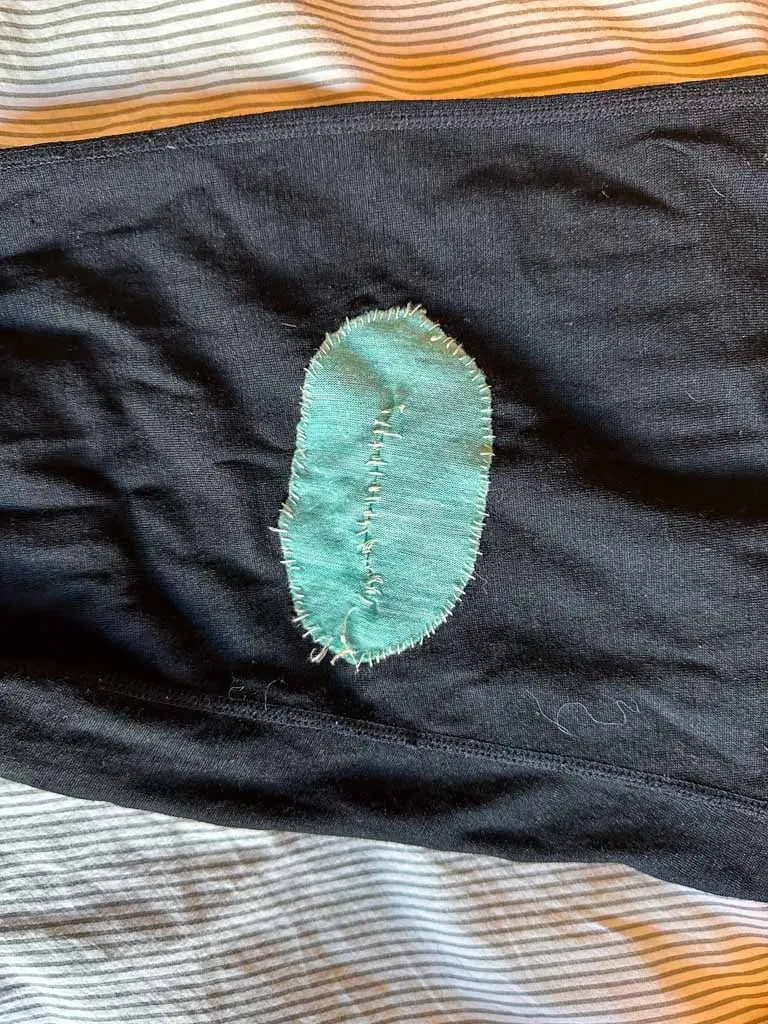If you’re shopping for hiking clothing you’ve probably heard all kinds of great things about Merino wool. But Merino isn’t perfect – to start with, it’s expensive. You might be wondering, is Merino wool worth it?
I’ve been hiking and backpacking for two decades (I even wrote a hiking guidebook) and have tried a lot of different technical outdoor clothing, including lots of Merino wool. I also spent seven years working at the head office of a large Canadian outdoor brand. While I was there, I worked closely with the design and fabric teams and wrote staff training material. So I have a pretty good grasp on outdoor fabric technologies.
In this article, I’ll break down the pros and cons of Merino wool so you can decide if it’s worth it for you. This Merino wool guide includes:
- Is Merino wool worth it? My quick answer
- What is Merino wool? How is it different than regular wool
- Merino wool pros and cons plus some neutral factors where wool is equivalent to other fabrics
- Which Merino wool clothing is worth it? Should you buy Merino socks, shirts, base layers, and more.
- Merino wool tips: My advice for buying merino, taking care of it, and repairing it
- Comparing Merino wool to other fabrics: How does it stack up to polyester, regular wool, alpaca, and more
- Merino wool FAQ: Answers to common questions like is Merino good for summer and does it shrink
Hey there: Some of the links in this post are affiliate links, which means I earn a small commission at no cost to you. Thanks for your support. -Taryn
Is Merino Wool Worth it?
My short answer: Most of the time, no.
The longer answer: Merino wool is a fabulous high-performance fabric. But it’s not magic. In many ways, Merino wool is comparable to high-tech polyester fabrics. The only place where Merino clearly outperforms is its ability to resist odors.
Some people really love the feel and performance of Merino. And if that’s you, and you find the expense and lack of durability of Merino don’t deter you, that’s great. If you love, Merino, keep on loving it.
But I think that a lot of people get sucked in by the premium price and slick marketing of Merino wool. They assume that because it is expensive, it must be the best. I’ve talked to lots of people who bought into the hype, then fell out of love with Merino after using it for a few years, mostly due to its lack of durability and high price.
If you are comparing a cheap big box store base layer to Merino wool, of course, Merino wool is going to be better. But if you compare Merino wool to high-end performance synthetic fabrics from innovative outdoor apparel companies, you’ll find that the synthetics provide equal or better performance at a cheaper price and with better durability.
What is Merino Wool?
Merino wool is the wool from a breed called Merino sheep. Although Merino sheep are originally from Spain, today they are found all over the world (and most famously, in Australia and New Zealand).

Merino wool is much softer and finer than regular wool. That means it is more comfortable to wear since it is less scratchy. The individual fibres of regular wool can be up to 40 microns in diameter. But Merino wool is always less than 24 microns. Premium fine Merino wool can go as low as 15 microns in diameter.
Merino wool is most often used for technical outdoor clothing. However, you can also find it in high-end casual sweaters and blankets.
Merino Wool Pros and Cons
Some people talk about Merino wool as if it is a miracle fabric. And it does indeed have lots of positive characteristics. However, there are also some negatives, which for some people (like me) often outweigh the positives.
Here’s my breakdown of the pros and cons of Merino wool. I’ve also included a few “neutral” factors – these are areas where Merino wool provides better performance than non-technical fabrics like cotton but has equivalent performance to technical fabrics like polyester.
Pro: Anti-Microbial
Merino wool is naturally anti-microbial. That means that it doesn’t get as stinky and odor-causing particles won’t build up in it over time like they can in synthetic fabrics like polyester and nylon. (Read my guide to getting the smell out of hiking gear for info on how that happens.)
Since Merino wool is less smelly, it’s a great choice for multi-day backpacking or situations where you can’t or don’t want to wash your gear as often. When I used to commute to work by bike, I wore a Merino wool shirt that I washed once or twice a week instead of every day.
But… Merino wool can still get stinky over time, especially if it is blended with nylon or elastane. It’s not magic. It just takes way longer to develop that signature hiker stank than other fabrics.

Pro: Temperature Regulation and Breathability
Merino wool is naturally thermo-regulating. That means that it can help you feel cool when it’s hot out and provide warmth when it’s cold. This sounds crazy, but there’s actually science behind it.
Wool fibres are crimped, which creates little air pockets. In cold weather, these air pockets trap warm air and hold it close to you. When it’s hot out, wool pulls moisture and heat from your body. As the wool dries and releases the moisture, the crimps trap cold air, keeping you cool.
Many people love Merino wool because they can wear the same Merino wool clothing in both summer and winter. The temperature-regulating properties of Merino wool also mean that you are less likely to need to add and remove layers as the temperature changes on a hike.
However, it is worth mentioning that there are lots of innovative premium synthetic fabrics that can compete with Merino on temperature regulation. But there are also lots of crappy synthetics too.
Pro: Warm for its Weight
The natural air pockets that give Merino wool its temperature-regulating properties also mean that it can provide more warmth for its weight than other fabrics. (Although the construction of some synthetic fabrics can mimic the air pocket structure and perform just as well.)
The excellent warmth-to-weight ratio means that you can choose thinner Merino wool garments than their synthetic counterparts.
Neutral: Next to Skin Comfort
You might hear Merino wool described as being comfortable to wear or soft against your skin. That is certainly true, especially when you compare it to traditional wool.
But it’s not any softer or more comfortable than some other technical fabrics like polyester. (Of course this depends a lot on the specific technical fabric. I find Merino wool much more comfortable than the polyester in my Outdoor Research Echo Sun Hoodie. But I also like the feel of my soft Mountain Hardware Crater Lake Sun Hoodie more than the feel of Merino wool. (I reviewed both of these in my guide to the best sun hoodies for hiking.)
Some people prefer the way Merino feels on their skin, but some still find it a tiny bit itchy.
Neutral: Provides Warmth When Wet
Merino wool still provides insulation even when it is wet. By itself, that sounds like a pro, and Merino wool cheerleaders often list “warmth when wet” as one of Merino wool’s strengths. But it’s only a pro if you compare Merino to cotton, since cotton makes you colder when you are wet. Synthetic fabrics also provide warmth when they are wet, so Merino doesn’t have a leg up over other technical outdoor fabrics.
Neutral: Moisture Wicking
Here is another neutral factor that masquerades as a pro. Yes, Merino wool does a good job of wicking moisture away from your skin thanks to the unique air pocket-forming structure of the wool fibres. But many technical synthetic fabrics are comparable when it comes to wicking, so it’s not a true pro. (However, some synthetics achieve high wicking performance via chemical finishes that wash out over time, so it’s not an easy comparison to make.)
Neutral: Ethical and Sustainability Issues
Merino wool is an animal product, so it is not vegan-friendly.
It is also important to know there have been issues around animal cruelty associated with Merino wool production. Some Merino sheep farmers subject their animals to mulesing, a painful practice that removes strips of skin around the anus. Mulesing protects the sheep from flystrike infections. It is done without anesthetic and is considered inhumane and unethical. Most developed countries no longer permit mulesing.
Before you buy a Merino wool garment, check to see if the manufacturer has a statement about the treatment of the sheep they source their wool from. You can also check to see if there are measures in place to prevent overgrazing and the excessive use of pesticides. There are many reputable and ethical Merino wool brands on the market including Smartwool, Icebreaker, Darn Tough, Ibex, Patagonia, Ridge Merino, and Woolx.
However, it’s worth pointing out that there are ethical issue around polyester too. It’s made from petroleum, which isn’t a renewable resource (unlike wool). And given the current climate crisis, fossil fuel extraction is something we should be moving away from rather than increasing
As well, fleecy fabrics release microplastics, which is a big problem when they are washed as it ends up in our waterways and oceans.
If you are concerned about the sustainability of your clothing, buying used base layers is the best choice.
Con: Doesn’t Dry Quickly
Merino wool is often touted as being great at moisture-wicking since it can absorb more moisture than other fabrics. The “moisture-wicking” part of that sentence is a pro. But the “absorb” part is a con because Merino wool really hangs on to moisture. It can take 40% longer for a Merino wool garment to dry compared to a synthetic one.
I sweat a lot (in all temperatures and during all activities). Merino wool just stays wet way too long for me. It takes forever to dry, and in the meantime, it’s heavy and gross.

Con: Durability
Unfortunately, Merino wool has a poor track record when it comes to durability. The fibres of Merino wool are very fragile. That means they are prone to ripping, tearing, and snagging. Even high-quality Merino wool garments are likely to develop holes.
There are a few things you can do to maximize the life of your Merino wool clothing. Garments that use a blend of Merino wool and synthetic fabrics are much stronger and last longer. I have lots of Merino wool socks from Darn Tough and Smartwool that have lasted years since they use a Merino wool/nylon blend.
You also have to be really careful with your Merino wool. Snags on zippers, watch straps, backpack buckles, jewellery, and belts are common ways to get holes. But friction holes are sometimes unavoidable, especially in the armpits and crotch.
Con: Special Washing Required
Merino wool requires special washing and drying. Like all wool, it shrinks if it is heated too much, which means it needs to be washed in cold water and hung to dry.
Due to its poor durability, it also is best to wash Merino wool clothing on the delicate cycle. I also always wash my Merino wool by itself to protect it. I don’t allow zippers, buttons, Velcro, or buckles in the washing machine with my Merino!
While it isn’t required, it is a good idea to use a wool-specific laundry detergent (like Nikwax Wool Wash). Regular detergent can strip the wool of its natural wicking properties and can contribute to pilling. Avoid enzyme cleaners at all costs as they can actually break down the fibres in Merino wool. (More tips in my guide to washing hiking gear.)

Con: Expensive
If you’ve ever shopped for Merino wool gear, you have probably been shocked by how expensive it is. Close to $100 for a t-shirt?? What?! Yup, Merino wool prices are crazy.
While there are billions of sheep in the world, most are raised for their meat or for regular wool. Merino sheep are a specialized breed and there just aren’t that many of them. It costs a lot more to raise a sheep than it does to harvest a plant or make fabric from petroleum. As well, the fine fibres of Merino wool mean that you need more of them to make fabric.
And while Merino wool is a natural fibre, it still needs to be heavily processed before it is turned into clothing. The fibres are extensively cleaned to remove dirt, impurities, and lanolin (a greasy substance that naturally occurs in sheep’s wool.)
Which Merino Wool Clothing is Worth It?
My answer to whether Merino wool is worth it depends on what kind of clothing you’re talking about. For things like socks, I recommend it 1000%. For shirts, base layers, underwear, and mid-layers, the answer is a bit more nuanced.
Are Merino Wool Socks Worth It?
Yes! I swear by Merino wool hiking socks.
Since socks need to be extra durable, Merino wool socks are usually expertly blended with nylon and elastane. This means that you get the anti-microbial and temperature-regulating properties of Merino. But you also get better durability thanks to the nylon. And you get the wicking power of both Merino and nylon – it dries quicker than Merino alone.
I hike exclusively in Merino wool blend socks. My favourites are the Smartwool Hike Light Cushion Crew Sock and the Darn Tough Light Hiker Micro Crew Lightweight Hiking Sock.

Are Merino Hiking Shirts Worth It?
Yes, but only for some people.
Many hikers love wearing Merino wool hiking shirts. They love the temperature regulation that Merino provides. And the anti-microbial properties of Merino make it ideal for backpacking trips when you don’t want to stink day after day.
However, when you wear a Merino wool hiking shirt, the poor durability of Merino wool becomes pretty apparent. And if you sweat a lot when you hike (like me) then you will find yourself soaking wet a lot of the time because Merino wool shirts absorb more water than synthetics and take longer to dry.
I think Merino wool hiking shirts are great for backpacking and for people who don’t sweat too much. They are also great for people who are careful with their gear.
Smartwool’s standard Merino Short Sleeve Tee is a really popular choice for a Merino hiking shirt. My husband has three of them and loves them. He likes that they don’t stink.
I have an Odlo Kinship Performance Wool long sleeve top that I love for cold weather hiking. It’s a wool/polyester/nylon blend that hits the sweat spot of performance for me. (Read my review in my fave gear of 2023 post.)

Are Merino Base Layers Worth It?
Yes, but only for some people.
The main purpose of a base layer (also known as thermals) is to move moisture away from your skin. Base layers also add warmth through insulation. (However, most of your warmth should come from your mid-layer.)
The thermo-regulation of Merino wool base layers is great for stop-and-start activities like skiing where you generate a lot of heat, but then slow down or stop for long periods and get cold.
Merino’s high warmth-to-weight ratio makes it great for base layers since you can get more warmth with less bulk. I usually sleep in Merino wool base layers when backpacking since they are smaller to pack.
However, for those who sweat a lot, Merino isn’t a good choice for active base layers since they absorb more moisture and take longer to dry.
Durability is also a factor with base layers – the repetitive rubbing of base layers against mid and outer layers in your crotch and armpits leads to pilling and holes far faster with Merino wool than with synthetic fabrics.
Merino wool base layers are great for skiing as long as you don’t run too hot and are ok with the durability issues. They also are great for sleeping in. Otherwise, I think synthetic base layers perform just as well so there isn’t any reason to spend more money on Merino wool.
I love my Smartwool Classic Thermal Base Layer Bottoms for sleeping on backpacking trips since they are lightweight, cozy, and come in fun prints. For snowshoeing, I wear Smartwool Intraknit Thermal Base Layers since they combine Merino and polyester for faster drying times.

Is Merino Wool Underwear Worth It?
Not really.
I’ve heard lots of rave reviews about Merino wool underwear. (And I included a few Merino wool pairs in my guide to the best hiking underwear since some hikers swear by them.) People love it for the same reason they love Merino wool hiking shirts – they are great at temperature regulation and they don’t stink.
But if you sweat a lot, Merino wool underwear is a disaster since it holds moisture, which can lead to uncomfortable chafing. Merino wool undies are also notorious for getting tons of holes. They often lose their shape a lot faster than synthetics too.
Lots of Merino wool underwear is heavily blended with nylon and elastane to increase durability and dry quicker. This is especially true of sports bras, which need to fit tightly. Some underwear and sports bras marketed as Merino wool contain less than 30% Merino wool… but still carry a full Merino wool price tag! Shop carefully.
If you love the feel of Merino wool and think the expense of Merino underwear is worth it, that’s great. But I don’t think Merino wool underwear is a great option for most people – if you are buying a $40 pair of undies, they shouldn’t get holes, bag out, and chafe your butt!
The only merino wool underwear I can recommend are the Branwyn Essential, although I find they are better for cold weather or less sweaty trips. But the highest rated Merino wool underwear are the women’s Icebreaker Merino Siren and Men’s Icebreaker Anatomica. If you want a Merino sports bra, I like the Smartwool Intraknit Strappy Bra – but keep in mind that it is only 28% wool and can definitely can get stinky. (Mine is a bit gross.)
Are Merino Wool Mid-Layers Worth It?
No. Synthetics greatly outperform Merino in this category.
Merino performs best when you wear it next to your skin to wick sweat and absorb heat. Merino wool does work as a mid-layer for insulation, but it doesn’t work any better than fleece, synthetic insulation, or down. And you need a much thicker wool mid-layer to get the equivalent warmth that you’d get with fleece, down, or synthetic insulation.
If you like the feel of wool, a blended wool and polyester fleece is a nice option for a casual mid-layer. But it will be heavier than a pure synthetic, dry slower, and be more expensive.
I have an older Smartwool Smartloft Jacket that I got years ago when I was a Smartwool brand amabassador. It has a Merino wool interior that is cozy, especially when layered over a short sleeved shirt. But I don’t find it as versatile to wear as a fleece.

Are Merino Wool Toques/Beanies Worth It?
Yes, if you don’t have sensitive skin.
I love my Smartwool Merino Beanie (called a toque here in Canada) – I’m wearing it in the photo above. It is really warm for the weight, so it doesn’t take up tons of space in my pack. Since I won’t be sweating much when I wear it, I don’t have to worry about it not drying quickly.
However, if you have sensitive skin, you might find that Merino wool itches your forehead a bit. In that case, a grid fleece hat like the Outdoor Research Trail Mix Beanie is a better option. It has the same warmth-to-weight as Merino wool.
Merino Wool Tips
From what to look for when shopping for Merino to how to wash and repair it, here are my top Merino wool tips:
- Choose the right Merino wool weight for your activity: Merino comes in weights from ultra-fine/ultralight light to heavy-weight. Lighter weights are good for warmer weather and more vigorous activity compared to heavier weights. Some brands list the grams per square metre (gsm) weight of the fabric. Look for around 150gsm for lightweight, year-round layers and 250-300gsm for extra warm winter layers.
- Get a close fit: To benefit from Merino wool’s thermoregulating properties, Merino clothing needs to fit close to the skin. It can’t be too baggy.
- Consider Merino wool blends: Merino wool blended with nylon, polyester and/or elastane is more durable, stretchier, and absorbs a bit less water than pure Merino. Some budget brands mix Merino with nylon to bring prices down. But other performance brands like Smartwool, Icebreaker and Odlo, mix Merino wool with other fabrics in innovative ways that boost function and fit. Pay attention to the percentages. You want at least 50% Merino, or else it’s not worth buying. If you prioritize the benefits of Merino but want more durability, look for 80-90% Merino.
- Buy from a brand that specializes in Merino: For the best performance, buy from a Merino wool brand like Smartwool or Icebreaker or an outdoor brand that makes lots of base layers like Patagonia, Odlo, Helly Hansen, and Arc’teryx. They will have the best fit, seam placement, and fabric blends. You can buy cheap Merino base layers from Costco, etc. but in my experience, they are poor quality and don’t last very long.
- Wash Merino carefully. If you baby your Merino wool, it will last. For the longest lifespan, always wash on delicate with wool-specific detergent (like Nikwax Wool Wash) and hang to dry. The care label might say regular wash and tumble dry is ok, but that’s because they don’t want to scare you off buying Merino. Trust me, stick with the delicate cycle and hang dry no matter what.
- Repair your Merino. Holes are inevitable, but that doesn’t mean you have to throw away your gear. Even if you are a terrible sewer, a few minutes with a needle and thread is all it takes to fix a small hole. For big ones, I sew on patches made from a pair of retired Merino base layer bottoms that was beyond repair.

Comparing Merino Wool to Other Fabrics
Most marketing material touts the performance values of merino wool, but doesn’t tell you how Merino stacks up in comparison to other common outdoor fabrics. I pitted Merino wool and against several other outdoor fabrics commonly used for base layers and hiking shirts.
Merino Wool vs Polyester
Merino wool wins over polyester in a few categories, but definitely not all of them. It’s important to note that there are tons of types of polyester fabric on the market. Higher-end tech fabrics with branded names will out-perform cheap unbranded polyester.
Merino wool is naturally anti-microbial, while polyester is prone to getting stinky. You can buy polyester with anti-odor properties, but it’s either a finish that washes out, or very expensive if it’s embedded in the garment.
For a lot of polyester fabrics, whether it is better than Merino or not, really depends on the type of polyester. In general, Merino is equivalent to or better than some (but not all) polyester fabrics when it comes to breathability, temperature regulation, warmth for weight, next-to-skin comfort, warmth when wet, and moisture-wicking.
All polyester will work better than Merino wool when you compare quick drying, durability, price, and washing instructions.

Merino Wool vs. Regular Wool
For hiking and other outdoor sports, Merino wool beats regular wool in pretty much every category except durability and price. It has better temperature regulation, breathability, next-to-skin comfort, and wicking than regular wool. Merino wool and regular wool score about the same when it comes to warmth for weight, warmth when wet, quick drying, and washing instructions.
Merino Wool vs. Polypropylene
Polypropylene is similar to polyester, but a bit less common. It wicks better, dries faster, and costs less than both polyester and Merino wool. It also gets stinky incredibly easily.
Polypropylene was commonly used in base layers in the 1990s but it is less prevalent now. Helly Hansen makes a lot of polypropylene base layers, some of which they blend with Merino wool. Choose polypropylene over wool if wicking and quick drying are your primary concerns and you can live with the stink.
Merino Wool vs. Modal/Tencel/Lyocell/Viscose/Rayon
Modal, Tencel, Lyocell, Viscose, and rayon are all semi-synthetic fabrics made from wood pulp. Some are softer and more eco-friendly than others (which makes them cost more.) They don’t provide any warmth. These fabrics don’t wrinkle and feel really soft (even softer than Merino), but they aren’t as good at wicking or quick-drying compared to Merino wool or synthetics. None of these fabrics are very good for outdoor clothing.
Merino Wool vs. Alpaca
Alpaca wool fabric is made from the wool of alpacas, a relative of the llama that lives in the South American mountains. Currently, most alpaca garments on the market are intended more for casual wear than for hiking or other outdoor activities. As well, most alpaca garments are heavily blended with other fabrics like nylon for durability or Tencel for softness.
Alpaca wool is softer than Merino. It is also a bit more durable, but still very fragile compared to synthetics. Alpaca is a bit warmer than Merino since its structure creates larger air pockets. (Alpacas need to stay warm in the chilly Andes Mountains!) Alpaca also retains a bit less water than Merino (but still doesn’t dry as fast as polyester or polypropylene).
The alpaca market is still growing so there will likely be a lot of options available in the next few years. But for now, most alpaca products are not high-tech enough for hikers.
Merino Wool vs. Cashmere
Cashmere is made from the wool of Kashmir goats that live in Afghanistan, China, India, Iran, and Iraq. While cashmere is warmer and softer than Merino, it doesn’t beat Merino in any other category. Cashmere is less durable, harder to wash, and more expensive. As well, cashmere is typically only used in casual wear, not in technical outdoor clothing.
Merino Wool FAQ
Let me answer some of the most common questions about Merino wool:
Is Merino Wool itchy?
No. Most people do not find Merino wool itchy, especially compared to regular wool. However, some people still find Merino wool a tiny bit itchy compared to other fabrics. Merino wool blends are less itchy than pure Merino wool.
Is Merino Wool Soft?
Yes. Merino wool is very soft, especially compared to regular wool. However, it can feel a tiny bit rougher than super soft fabrics like Modal or even some types of polyester.
Is Merino Wool Warm?
Yes. Merino wool provides great warmth for its weight compared to other fabrics. However, it is also naturally temperature regulating, which makes it great in a range of temperatures.
Is Merino Wool Good for Winter?
Yes. Merino wool base layers can provide lots of warmth, especially mid- and heavy-weight Merino (200-300gsm). However, you will still need insulating mid-layers on top of your Merino.

Is Merino Wool Good For Summer?
Yes. Merino wool is great for temperature regulation so lightweight Merino wool pieces (150gsm) work well in the summer. However, keep in mind that Merino wool doesn’t dry as quickly as synthetics, so if you sweat a lot, you might not like Merino wool for summer use.
Is Merino Wool Washable?
Yes. But it has special washing instructions. To make your Merino wool last, it is best to wash it in cold water on the delicate cycle, use wool-specific detergent, and hang it to dry. The care label on some Merino wool clothing says you can wash it on the regular cycle and tumble dry. But I don’t recommend it unless the Merino is blended with another fabric (for example Merino wool blend hiking socks).
Does Merino Wool Shrink?
Yes. Like most wool, if you wash it in hot water or put it in the dryer, it will shrink at least a little bit. But if you wash it in cold water and hang to dry, it won’t shrink.
Is Merino Wool Expensive?
Yes, compared to other fabrics, Merino wool is quite expensive. That is because Merino wool is expensive to produce – raising and shearing sheep is more expensive than growing cotton or processing petroleum.
So that’s my big explanation of why I think Merino wool isn’t always worth it. I’m sure some of you will disagree, and that’s ok. I’ll be the first one to say that Merino wool is an awesome fabric. It’s just not always the best one to choose for every application.
Do you have more Merino wool questions? Ask them in the comments.
READ NEXT:
- How to Get the Smell Out of Hiking Clothes
- Why Do Rain Jackets Wet Out?
- My Favourite Hiking Gear – 2023 Edition
- Best Hiking Underwear For Women and Men
- 20+ Ways to Reduce Your Backpack Weight
- Lake O’Hara Packing Lists for Hikers and Campers - April 25, 2025
- BC Parks Day Passes 2025 – Everything You Need to Know - April 24, 2025
- Best Women’s Hiking Pants (Picks for Every Body Type) - April 21, 2025


Nadine
Tuesday 26th of March 2024
Hello Taryn, have been enjoying your blog, got to it researching the overland track. Regarding merino, what do you wear on multi-day hikes? As it sounds you don't like merino much because it dries slowly. I get so hot and sweaty myself, even in colder temperatures that I use merino because other shirts stink so much. Then put my rain jacket on if having a break because the by then soaked and sweaty merino will make me feel cold otherwise. I have tried expensive synthetic hiking shirts, but they stink after the first day. Even those with odour control. So I just keep going with merino. I have 1 shirt for walking and 1 for the hut/camp for let's say a 6 day trip and at least it doesn't stink (I don't take deodorant as saving weight wherever I can, maybe that would help?) Do you have a magical solution you could share? Thanks for your blog from NZ!
Taryn Eyton
Wednesday 27th of March 2024
I wear a synthetic sun shirt (OR Echo, Patagonia Capilene Cool, or Mountain Hardwear Crater Lake) on backpacking trips. They all dry quickly, which is my priority. I do sometimes wear merino wool shirts to sleep in or at camp where I'm not sweating. I prioritize quick drying over anti-stink. All of my shirts don't smell great after a week in the backcountry, but I'm ok with that if it means that I don't feel soaking wet all the time. But if merino wool is already working for you, stick with it. As I said in my article, there are pros and cons to merino wool and each person should evaluate them for themselves.
Nicole
Wednesday 10th of January 2024
While you touched on the animal welfare side, I don't believe being a non-vegan material is a con, as some sheep can not shed their wool naturally and need to be sheared in order to improve their quality of life. More importantly, I would have liked to see the sustainability impact in your assessment. I agree with the importance of doing research to ensure proper animal treatment, but what about research into the sustainable impact of the fabric used. The fact that wool is a natural product that is renewable is a huge pro compared to polyester fabrics that are derived from fossil fuels. You are wearing plastic that will not decompose in our lifetime, which significantly contributes to microplastic shedding contaminating our oceans, and has no end of life solution. Wool is biodegradable and decomposes naturally back to earth. The world is experiencing a climate crisis, and expressing the importance of choosing sustainable fashion will be impactful.
Taryn Eyton
Thursday 11th of January 2024
Thanks for the comment Nicole, this is a good point and something I was definitely aware of but spaced out on including when I was putting this piece together. It was definitely an oversight. I've updated the article to list ethical/sustainable issues as a neutral since I added in the negative aspects of polyester.